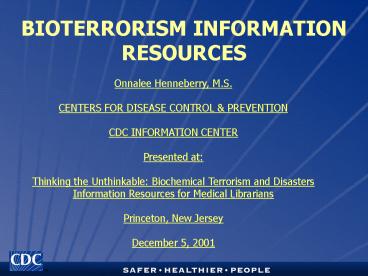BIOTERRORISM INFORMATION RESOURCES - PowerPoint PPT Presentation
1 / 21
Title:
BIOTERRORISM INFORMATION RESOURCES
Description:
Information Resources for Medical Librarians. Princeton, New Jersey ... Definitions: Department of Defense Dictionary of Military and Associated Terms ... – PowerPoint PPT presentation
Number of Views:70
Avg rating:3.0/5.0
Title: BIOTERRORISM INFORMATION RESOURCES
1
BIOTERRORISM INFORMATION RESOURCES
Onnalee Henneberry, M.S. CENTERS FOR DISEASE
CONTROL PREVENTION CDC INFORMATION
CENTER Presented at Thinking the Unthinkable
Biochemical Terrorism and Disasters Information
Resources for Medical Librarians Princeton, New
Jersey December 5, 2001
2
Bioterrorism - Categories of Information Using
the Information Scenario Exercise
3
Categories of Information Definitions CDC Oth
er U.S. Government U.S. Military State/Local
Government Non-governmental/educational Backgrou
nd reports/articles/books
4
Definitions Department of Defense Dictionary
of Military and Associated Terms
www.dtic.mil/doctrine/jel/new_pubs/jp1_02.pdf
5
- U.S. Government Executive
Branch -
President -
Cabinet - Department of Agriculture (USDA)
- Department of Commerce (DOC)
- Department of Defense (DOD)
- Department of Education
- Department of Energy
- Department of Health and Human Services (HHS)
- Centers for Disease Control Prevention
- Department of Housing and Urban Development (HUD)
- Department of the Interior (DOI)
6
Department of Health and Human Services HHS
7
Centers for Disease Control Prevention Bioterror
ism Resources http//www.bt.cdc.gov
Image Information
8
http//www.bt.cdc.gov - the Centers for Disease
Control Prevention Bioterrorism Web page
9
(No Transcript)
10
- Steps in Preparing Public Health Agencies for
Biological Attacks - Enhance epidemiologic capacity to detect and
respond to biological attacks. - Supply diagnostic reagents to state and local
public health agencies. - Establish communication programs to ensure
delivery of accurate information. - Enhance bioterrorism-related education and
training for health-care professionals. - MMWR 49RR-4, April 21, 2000
11
- Prepare educational materials that
will inform and - reassure the public during and after a
biological attack. - Stockpile appropriate vaccines and drugs.
- Establish molecular surveillance for microbial
strains, - including unusual or drug- resistant strains.
- Support the development of diagnostic tests.
- Encourage research on antiviral drugs and
vaccines. - MMWR 49RR-4, April 21, 2000
- MMWR 49RR-4, April 21, 2000
- source Biological and Chemical
TerrorismStrategic Plan for Preparedness and
Response.
12
- Critical biological
agents - Category A
- can be easily disseminated or transmitted
person-to-person - cause high mortality, with potential for major
public health impact - might cause public panic and social disruption
- require special action for public health
preparedness - MMWR 49RR-4, April 21, 2000
13
- Category A agents include
- variola major (smallpox)
- Bacillus anthracis (anthrax)
- Yersinia pestis (plague)
- Clostridium botulinum toxin (botulism)
- Francisella tularensis (tularaemia)
- filoviruses
- Ebola hemorrhagic fever
- Marburg hemorrhagic fever
- arenaviruses
- Lassa (Lassa fever)
- Junin (Argentine hemorrhagic fever) and related
viruses - MMWR 49RR-4, April 21, 2000
14
-
Category B - are moderately easy to disseminate
- cause moderate morbidity and low mortality
- require specific enhancements of CDC's diagnostic
capacity and enhanced disease surveillance - MMWR 49RR-4, April 21, 2000
15
- Category B agents include
- Coxiella burnetti (Q fever)
- Brucella species (brucellosis)
- Burkholderia mallei (glanders)
- alphaviruses
- Venezuelan encephalomyelitis
- eastern and western equine encephalomyelitis
- ricin toxin from Ricinus communis (castor beans)
- epsilon toxin of Clostridium perfringens
- Staphylococcus enterotoxin B.
- MMWR 49RR-4, April 21, 2000
16
- subset of List B agents includes pathogens that
are food- or waterborne - these pathogens include
but are not limited to - Salmonella species
- Shigella dysenteriae
- Escherichia coli O157H7
- Vibrio cholerae
- Cryptosporidium parvum
- MMWR 49RR-4, April 21, 2000
17
-
Category C - Includes emerging pathogens that could be
engineered for mass dissemination in the future
because of - availability
- ease of production and dissemination and
- potential for high morbidity and mortality and
major health impact. - Category C agents include
- Nipah virus
- hantaviruses
- tickborne hemorrhagic fever viruses
- tickborne encephalitis viruses
- yellow fever
- multidrug-resistant tuberculosis
18
Classification of Bioterrorism Laboratories
D - High level characterization (seek evidence of
molecular chimeras) and secure banking of
isolates
Safety proficiency to probe for universe of
bio- and chemical agents in non-clinical specimen
Level D Lab BSL-4
C - Safety and proficiency sufficient to probe,
type, perform toxigenicity testing
Level C Lab BSL-3
B - Safety and proficiency adequate to confirm
characterize susceptibility
Level B Lab Work at BSL-3 with BT agents
A - Adequate safety to rule-out and forward
organisms
Level-A Labs - Assess Risks for Aerosols and Use
Biosafety Cabinet
19
Bioterrorism Info for Healthcarehttp//www.cdc.
gov/ncidod/hip/Bio/bio.htm
20
http//www.cdc.gov/ncidod/hip/Guide/guide.htm
21
National Pharmaceutical Stockpile http//www.cdc.g
ov/nceh/nps/default.htm

